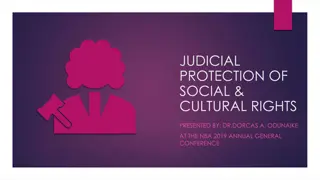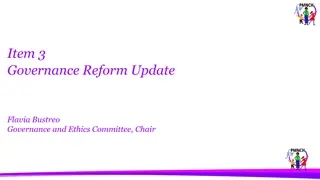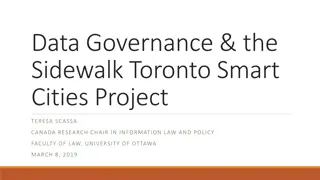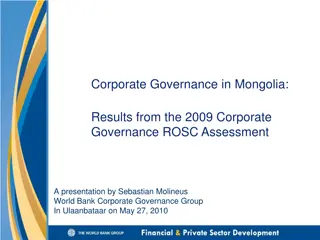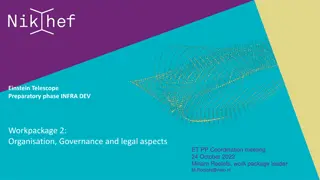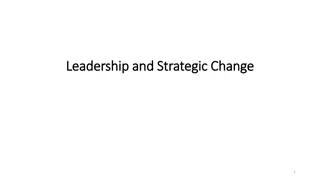Cultural Change Leading to New Governance: Key Dimensions and Challenges
Impact of cultural change on governance structures, highlighting key dimensions such as role clarity, traditional board approaches, and organizational culture. Learn how developing a positive culture can enhance board effectiveness and overall organizational performance.
Download Presentation

Please find below an Image/Link to download the presentation.
The content on the website is provided AS IS for your information and personal use only. It may not be sold, licensed, or shared on other websites without obtaining consent from the author.If you encounter any issues during the download, it is possible that the publisher has removed the file from their server.
You are allowed to download the files provided on this website for personal or commercial use, subject to the condition that they are used lawfully. All files are the property of their respective owners.
The content on the website is provided AS IS for your information and personal use only. It may not be sold, licensed, or shared on other websites without obtaining consent from the author.
E N D
Presentation Transcript
Cultural Change Leading to New Governance
Culture Traditional Approach of Boards of Management Lack of role clarity, Boards relied on the fact that the ETB s were the corporate body, The buck did not stop with the Board, Members considered themselves representatives of their nominating body & never left that role, Lack of cohesion as a consequence; dysfunctional management system with everything left to Principals
Culture What is culture? It is shared beliefs and values It is the way we do things around here Culture eats strategy for breakfast Every day and all day Poor Culture will defeat a great strategy Culture is hard and real, it is not soft and fluffy The development of an effective culture needs proactive and consistent direction and management It demands commitment at senior levels (People who Walk the Talk) It is about norms and behaviours - not aspirations
What is Organisational Culture? It is the rules, systems and procedures that set the parameters for behaviour It is the beliefs, values and attitudes displayed in everyday activities
Culture & Organisational Effectiveness Culture is at the core of organisational effectiveness and performance Culture is either consciously shaped or it just emerges if it is not actively built and managed If you leave it to chance you are more likely to get a culture that does not suit and one which is counter productive
Areas Needed for Change - Developing a Positive Culture Identification of the changes that will make the difference and move towards a positive and enabling culture for boards of management: Role Clarity Bias to Action (moving boards from passive to active) Performance Management and Accountability of boards (how Boards know if they are going a good job) Recognise and Reinforce the Required Behaviours
Governance Corporate Governance
STATUTORY DUTIES ASSIGNED TO THE BOM (A) Education Act, 1998 Functions of a Board including S.15 Admissions and Participation Policy (S.15(2)(d)) Note: Education (Admission to Schools) Bill 2015 (No. 35/2015) Report and Information to Parents (S.20) The School plan (S.21) (B) Education (Welfare) Act, 2000 School Attendance Strategy (S.22) Code of Behaviour (S.23) (NEWB /TUSLA Guidelines May 2008 Expulsion of Student from recognised school (S.24) (C)Education for Persons with Special Educational Needs Act, 2004 S.14 Duty of Schools
Changing Environment Driving New Governance Each of the 16 ETBs must transform the education, training and youth work services within their expanded remit Lead and manage enhanced remit & functions Effective discharge of remit including training over expanded geographical area New governance structures are emerging to ensure this happens
Department Circular Driving New Governance Complying with the Code of Practice for the Governance of Education and Training Boards as issued by the Department of Education and Skills with Circular Letter No. 0018/2015 See copy in folder Application of Corporate Governance Principles to each and every education and training service.
Circular Letter No. 0018/2015 1.1 Corporate governance comprises the systems and procedures by which entities are directed and controlled. State bodies, including Education and Training Boards (ETBs), must serve the interests of the taxpayer, pursue value for money in their endeavours (including managing risk appropriately), and act transparently as public entities. 1.2 In order to deliver good governance in the ETB, the Board must act in the interest of the ETB at all times, consistent with the requirements of legislation and government policies, avoiding self-interest and the interests of third parties, including bodies which have elected or nominated them.
ETB & MANAGEMENT OF RECOGNISED SCHOOL(S) Section 10(1) of the ETB Act includes the establishment and maintenance of recognised schools as one of an ETBs General Functions ETB will delegate the management of each recognised school to a Committee/Board of Management established under Ss44(i) of the Act as provided for in Part IV: Boards of Management of Education Act, 1998
Governance The systems and processes concerned with the overall direction, effectiveness, supervision and accountability organisation Good Governance: A code for the Community and Voluntary Sector (2012) of an school's that are at risk of failure are usually poorly governed
Governance Governance exists to translate statutory requirements, national policies and the requirements of the ETB into effective school performance. Everybody on a board must know what their job is. Board holds its authority as group The Board should speak with one voice This commitment to authorative unity does nor compromise anyone s right to speak their mind. Board have their arms around the school (without having their fingers in it). Control with meddling. (Carver 2010) The Board are not management one step up they are ownership one step down (owners: State, ETB & Community)
The Good Governance Code The Governance Code (for community and voluntary sector) is based on five main principles: 1. Leading the organisation 2. Exercising control over the organisation 3. Being transparent and accountable 4. Working effectively 5. Behaving with integrity
GOVERNANCE FOR A SECOND LEVEL SCHOOL Primary role of each Board of Management/Board of Governance is one of Governance Governance requires; direction, oversight and Control Governance is about rights and responsibilities and ensuring they are fulfilled. Knowing your school is central to discharging this effectively
GOVERNANCE FOR A SECOND LEVEL SCHOOL The main Governance functions of a Board of Management are: Policy formation and strategic planning Monitoring the implementation of Policy, Strategy, and Plans Supporting the Principal and his/her staff The best Boards comply with the five principles of good Governance by: Providing leadership Exercising control Being transparent and accountable Working effectively Behaving with integrity Greater focus on the ends rather than the means .
Good School Governance Good governance is a highly formalised activity where conformity to locally and nationally specified rules and roles is important good governance involves compliance with standard procedures; Good governance involves executing specific tasks in accordance with accepted understandings of internal standards of practice. Good practice is grounded in procedural rules to govern the activities of the school; Good governance involves high quality interpersonal relations and effective communication, including appreciating the work of staff, avoiding open conflict and avoiding unpleasant surprises. (Brennan 2011)
Financial Accountability Members as Non-Executive Directors Traditional Fiduciary Duty Each of Board of Management is accountable for: Monies allocated by the ETB/DES All other accounts held in the name of and/or for the benefit of the school
CONFIRMATION OF ACTS OF EACH COMMITTEE/BOARD OF MANAGEMENT OF AN ETB Section 44(18) of Act provides that the acts (decisions) of every committee shall be subject to confirmation by the Education and Training Board This is of crucial importance Effective communications (which are fully documented) between BOM and ETB is essential for school governance
ASSURANCE TO MEMBERS OF BOARDS OF MANGEMENT Members of the Board of Management of an ETB School who discharge their governance functions, including, their various statutory functions, within their Terms of Reference and in good faith have no reason to be concerned (Section 14(7) of the Education Act, 1998) So if Board management discharge the duties appropriately their decisions will stand up to scrutiny and the ETB will be able to stand over the decisions.
8 Characteristics of Effective Boards Effective school boards commit to a vision of high expectations for student achievement and quality instruction and define clear goals toward that vision Effective school boards have strong shared beliefs and values Effective school boards are accountability driven, spending less time on operational issues and more time focused on policies to improve student achievement. Effective school boards have a collaborative relationship with staff and the community and establish a strong communications structure to inform and engage both internal and external stakeholders in setting and achieving district goals 1. 2. 3. 4.
8 Characteristics of Effective Boards Effective school boards are data savvy: they embrace and monitor data, even when the information is negative, and use it to drive continuous improvement. Effective school boards align and sustain resources, such as professional development, to meet goals. Effective school boards lead as a united team, each from their respective roles, with strong collaboration and mutual trust. Effective school boards take part in team development and training, to build shared knowledge, values and commitments for their improvement efforts. 5. 6. 7. 8. (Waters and Marzano (2006) USA)
Governance is Central to School Success Governance matters and the effect is significant Empirical international research bears this out The challenges for leaders is to change the culture. It is Time for school leaders to seize the initiative. If there is to happen it will be based on sound governance. Ultimately, the success of school boards depends on governance structures but also the interpersonal relationships around the school board table and on the social chemistry of the group.







